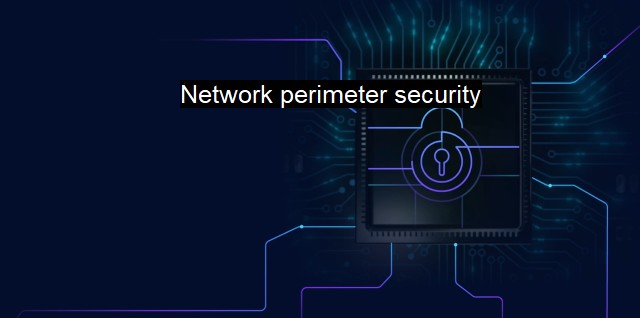What is Network perimeter security?
The Importance of Network Perimeter Security: Protecting Your Organization from External and Internal Threats Through Cybersecurity Strategies and Tools, Including Anti-Virus Solutions
Network perimeter security refers to the safeguards put in place to protect the boundary between an organization's internal network and the outside world, typically the internet. This concept is at the forefront of cybersecurity efforts as it's the first line of defense against outsiders who aim to compromise or disable systems and gain unauthorized access to sensitive data inside an organization.Companies, institutions, or organizations devise various strategies to fortify their network perimeter against such threats. These comprehensive approaches used mitigate risks posed by hackers, viruses, ransomware, and other forms of malicious software. Safeguarding an entity's network perimeter, regardless of whether the entity is an individual or a multinational company, is crucial for personal privacy protection and maintaining corporate confidentiality.
Before delving further into the concept of network perimeter security, it is important to elaborate on the idea of a network perimeter. a network perimeter is the boundary that marks the inflection point between a network's internal and external components. In simpler terms, it is the figurative "wall" that separates the public internet from the internal systems that are exclusive to a specific entity. Organizations deploy a variety of devices, technologies, and procedures at this network perimeter to establish a protective barrier.
Primarily, network perimeter security is built around the concept of 'defense in depth.' This means that the solutions employed are not singular in nature but are rather layers of defenses. This multi-layered strategy to cybersecurity includes firewall systems, intrusion prevention systems (IPS), and secure web gateways amongst others.
Firewalls, perhaps the earliest form of network perimeter security, act as enforces of traffic rules between an organization's internal network and the wider internet. They scrutinize data entering and leaving the network, permitting only legitimate traffic and blocking patterns that suggest malicious intent.
On the other hand, Intrusion Prevention Systems, go further than firewalls. They examine data passing across the network for unusual patterns or signs of hacking attempts and thwart those efforts. They not only block threats but also provide vital information about the nature of the threat to the organization's administrators.
In conjunction with IPS, Secure Web Gateways filter access to untrustworthy websites and web applications to reduce an entity's susceptibility to viruses, spyware, and other forms of malware. By doing so, they offer deeper, wider coverage mitigating cyber threats.
Another important aspect of network perimeter security is timely and routine patches and updates. Technology developers routinely discover vulnerabilities in their hardware or software products. They subsequently issue patches or updates to fix these vulnerabilities that malicious hackers might otherwise exploit to breach the network perimeter. Consequently, entities must promptly install these patches and updates.
One must also consider the emergent trend of perimeter-less networks. In our current age of remote work, mobile devices, and cloud technologies, the clearly defined network perimeters of old are becoming redundant. The concept of zero trust network strategy comes into play, that advocates that entities should not automatically trust anything either inside or outside its perimeters but it verifies everything seeking connection before granting access.
Thus, while the cyber-threat landscape continually evolves, network perimeter security remains a fundamental tenet of cybersecurity strategy. By implanting a multi-layered defensive system, including firewalls, IPS, and secure web gateways, coupled with routine updates and adopting new strategies like zero trust networks, organizations can assure the robustness and integrity of their informational systems and keep cyber threats at bay. Whether fighting against simple viruses or making attempts to repudiate complex malicious software, network perimeter security is an indispensable guardian of organizational sanctity in the digital world.

Network perimeter security FAQs
What is network perimeter security?
Network perimeter security refers to the practice of securing the boundary of a network. It involves implementing security measures that can protect the network from unauthorized access, data breaches, and other security threats.What are some common network perimeter security measures?
Some common network perimeter security measures include firewalls, intrusion prevention systems, virtual private networks (VPNs), access controls, and antivirus software. These measures can help identify and prevent unauthorized access to the network, detect and stop attacks, and ensure that data is protected.Why is network perimeter security important in cybersecurity?
Network perimeter security is important in cybersecurity because it provides the first line of defense against cyber attacks. Cybercriminals often target the perimeter of a network because it is the easiest point of entry. A strong perimeter security system can help prevent or mitigate these attacks, protecting the network and the data it contains.How does antivirus software fit into network perimeter security?
Antivirus software is an important component of network perimeter security because it can help identify and block malware before it enters the network. Antivirus software can scan incoming traffic for known viruses and malware, and also use behavior-based detection methods to identify new or unknown threats. By stopping malware before it can enter the network, antivirus software can help prevent data breaches and other security incidents.| | A | | | B | | | C | | | D | | | E | | | F | | | G | | | H | | | I | | | J | | | K | | | L | | | M | |
| | N | | | O | | | P | | | Q | | | R | | | S | | | T | | | U | | | V | | | W | | | X | | | Y | | | Z | |
| | 1 | | | 2 | | | 3 | | | 4 | | | 7 | | | 8 | | |||||||